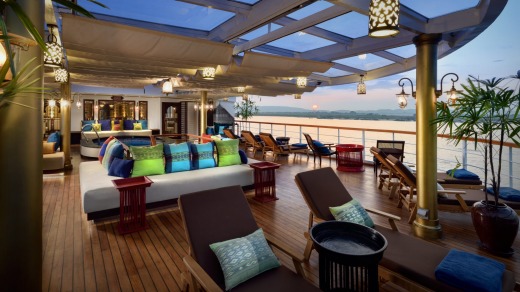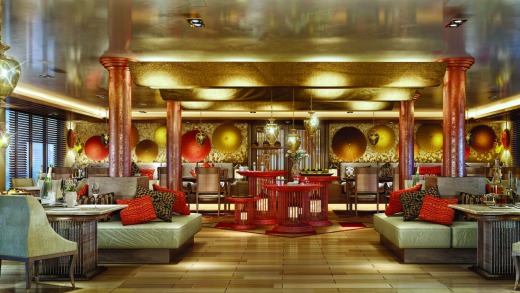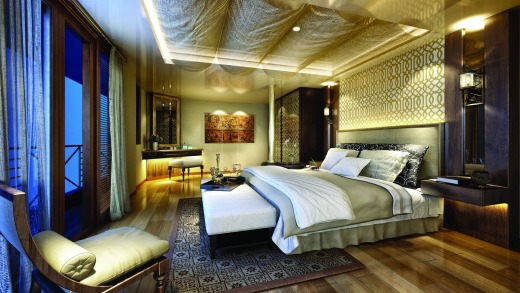Before we fly to Yangon to take a boat up the Irrawaddy River, I am sent a copy of Burmese Days by George Orwell.
First published in 1934, Orwell's book tells of waning British colonialism when Burma was ruled by the British, and his time as an imperial policeman. The book is a good primer; even now, you can see Orwell's Burma in the crumbling grand old buildings in Yangon, and the refurbished, very colonial hotel The Strand, where you can sip gin and tonics under slow-moving ceiling fans.
Now going by its old name of Myanmar, the country is going through yet another change.

Sanctions are lifting - and since Aung San Suu Kyi has been released from house arrest - the country is experiencing a tourist boom.
It's still undergoing growing pains. Whilst a nominally civilian government has been installed and political prisoners released, Myanmar is back in the news for the country's mistreatment of the Muslim Rohingya minority and it remains one of the poorest countries in Asia.
Yet there are things I saw in Burma that I will never forget - the sunset over the temples of Bagan as seen from a hot air balloon, a candle-lit dinner on the riverbanks of the Irrawaddy, the chaotic and colourful street life in the capital Yangon.

Rudyard Kipling was right when he said, "This is Burma. It is quite unlike any place you know about."
Everyone wants to go there but the hotel industry is struggling to keep up with demand.
It is rather ingenious then for high-end tour operators such as Abercrombie and Kent to build a luxury boat that allows visitors to see some of Myanmar's most extraordinary sites - from stunning temples and stupas (structures containing relics), to villages and riverbanks - while travelling up the majestic Irrawaddy, Myanmar's largest river and most trafficked trading route.

We are aboard Sanctuary Ananda on one of her early voyages.
There are 21 spacious suites for no more than 48 passengers, with the dimensions and finishes of a 5-star hotel room, although with none of the sleek, neutral lines that strip an interior of any hints as to its provenance.
The boat was custom-made in Yangon for this river (the ship was built with a flat bottom with a 1.32 metre draft so it can sail in all seasons, even when other ships are forced to dock because the waters are too shallow) and for this part of the world. It is small-scale, built locally and to high environmental standards, featuring interiors made from bright, handmade fabrics from the country's different ethnic groups and decks shining with suspended lanterns.
Every cabin has an Ipod docking station and Ipad TV but Wi-Fi can be patchy, though the village life happening on the banks of the river is far more fascinating than anything on BBC World Service.
Sanctuary Ananda 🏯 Descubra os mistérios de #Myanmar ( #Burma ) em um cruzeiro pelos Rios #Ayeyarwady e #Chindwin entre Bhamo e Yangon visitando Templos,Pagodas,Palácios e Monastérios☀Benefícios Plantur✔️Early Check-in✔️Late Check-out✔️e outros➡️Saiba Mais☎️(011)5533-3644📩[email protected]📞WhatsApp das 9h as 18h(011)99603-1211 ✈️☀️🏯 #sanctuaryananda#Birmania#Bhamo#yangon#rivercruises#spa#amazing#trip#adventure#aventura#culture#sanctuary#river#explore#viaje#experience#beautifuldestinations#templos#beautiful#viagem#wanderlust#ferias#lovetravel#travel#travellermade#plantur_turismo ✈️☀️🏯✈️☀️🏯✈️☀️🏯✈️☀️🏯
On our first day we fly from Yangon to Mandalay, where the Sanctuary Ananda is docked. We are greeted by Abercrombie and Kent founder Geoff Kent.
He believes Myanmar is one of the world's most unspoilt destinations, and the best way to see it, he tells us, is from the water.
We will spend four days on the boat cruising the Ayeyarwady River from Mandalay to Bagan, and although much of our time is spent on land, there is plenty of time to enjoy the luxury of the ship. Highlights include the high, comfortable beds that open up to a balcony facing onto the river, and the day spa that offers special Burmese massages that feel even more relaxing and lulling when the ship is moving down the river.
The top deck is also a popular place to hang out. There's yoga and meditation in the morning, comfortable lounges, an icy plunge pool and a fantastic bar - with a speciality "mixologist". I love his margaritas. The bar becomes - naturally - a popular place to meet before dinner, where guests mingle with one another before being seated down on a lower deck for dinner.
Executive Chef Sumet Sumpachanyanont was recruited from Bangkok's Mandarin Oriental Hotel. Expect Burmese dishes as well as a smattering of Thai and Asian cuisines.
We were lucky enough to accompany the chef one afternoon to the market at one of our stops and he talked us through a variety of exotic herbs he purchased for that night's dinner.
Our first day in Mandalay starts with a delicious breakfast - not aboard the Ananda but at a roadside cafe that before 9am is teeming with people.
Watching the sunrise over Bagan #myanmar #asiatravel #travellerau One of the best places in the world for hot air balloon ride. @bengroundwater definitely the best thing to do in Myanmar
Our guide (all the Abercrombie and Kent guides are local Burmese) advises to get the local specialty - mohinga, which is delicious : coconut milk with chicken, chickpeas, coriander, chilli, onion, garlic and lemongrass. Yum! We enjoyed it with a side of samosas and washed down with tea.
One of the joys of eating in a bustling road-side cafe is the people watching. There are more than 53 million Buddhists in Myanmar, and a stint in a monastery is compulsory for children aged around seven, and then as older teenagers.
It was almost impossible to resist photographing the baby Buddhist nuns in their light pink robes and shaved heads, or the teenage boys in burgundy robes travelling on the back of trucks, or hanging outside the roadside cafe, texting and chatting to friends. The rules are that the young monks are meant to not make eye contact, their gaze pitched somewhere towards the ground but some of them seemed as curious about us, as we are about them.
Gold stupas dot the landscape around Mandalay. The dominance of religion in daily Burmese life is obvious as we stop off at some of the region's temples. Not only are they impressive monuments, but they are also busy, daily places of worship, filled with locals praying, making offerings and shopping for everything from snacks to religious iconography to jewellry.
We visit three major religious sites in Mandalay on the first day: Mahamuni pagoda - Mandalay's holiest shrine featuring a four-metre buddha, the fascinating Kuthodaw pagoda which has the "biggest story book in the world" (essentially 729 stunning white stone-inscription caves) and the Shwenandaw Monastery.
This monastery - built in 1880 - was constructed in traditional Burmese style, and is known for its teak carvings of Buddhist myths, which adorn its walls and roofs.
We visit the U Bein Bridge - the world's longest and oldest teak bridge. It's sunset and a boatman takes a few of us out on a gondola, where scores of people standing on the bridge are silhouetted against the setting sun, like a living postcard. When we return to shore a table has been set for us with flutes of champagne.
Then it's back to the boat for dinner and sailing upriver overnight, and that beautiful lulling feeling of being rocked to sleep as the boat chugs almost noiselessly along.
The following day we start early up on the deck (in fact most of the starts were early - and if you decided to carouse with fellow passengers in the bar or on the deck - the nights were late) with a meditation class. On the banks of the river are women washing clothes.
Then its off the boat to visit Sin Kyun, a village typical of those in Myanmar - it is rural, remote and poor. Abercrombie and Kent are financially supporting the village with a teacher and building a schoolhouse. For us, it's a good chance to see up close how residents close to the river live.
The children are friendly and meet us off the boat in their bright, neatly-pressed flannel pyjamas. The adults around are mostly working - on the fields driving oxen or in their huts hat-making, the local industry here. Life here appears to be unchanged from what it would have been like a century ago.Tourism is still in its infancy here. I can't help but wonder what impact - for better or worse - it will have on the lives of the villagers here.
At the next stop - the village of Mingun - we are transported by oxen to the Mingun pagoda housing the massive Mingun bell - measuring 3.5 metres tall and 4.9 metres wide. There are more western tourists here than I have seen in other parts of Myanmar - and the touts have caught on, greeting us as we get off the boat, trying to sell jade necklaces and swathes of fabric. You can't blame them - many people in Myanmar survive on less than $2 a day and tourism is a chance to earn money outside the usual industries of factory work or agriculture.
I enjoy respite from the temples in a local cafe - enjoying a freshly macheted coconut under the cool shade of a banyan tree, before hopping back on my oxen and heading for the boat.
Back on board the Ananda there are plenty of activities including longhu (sarong) and thanaka (cosmetic) demonstrations, a cooking demonstration with the chef and a talk by a historian on Myanmar's recent troubled, but fascinating history.
A few nights later a small group of us enjoy a fascinating dinner under the trees at beautiful, candlelit Le Planteur restaurant back in Yangon with Suu Kyi's former assistant, Ma Thanegi.
Ma Thanegi was jailed under the junta and now works as a journalist. She is not only great company but is outspoken about the continuing rocky road to democracy. Many others locals we meet are much more hesitant about talking about life under the new regime. Saying An Suu Kyi's name is still taboo with some locals - a hangover from the old days. They refer to her instead as "the Lady".
On our third morning on the ship, we are brought once again down to earth to see how people live in rural Myanmar. I find moving between the luxury of the ship and seeing up close the lives of Myanmar's working poor can be a jarring at times - but I'm glad for it. This is not a tour where the realities of a country are hidden from the guests.
We attend a busy local market in the town of Pakokku where the chef takes us on a fruit and vegetable tour, and buys some ingredients for dinner.
I buy a really, long, unusual smelling bar of soap for 15c.
Then it's onto a cheroot factory - where women - usually unmarried women who have no family support roll hand roll up to 1000 cigars a day. They earn around $2 a day for this. I find this depressing, but through an interpreter I speak to some of the women who tell me they are happy to have work.
I purchase a box of cigars and smoke them on the deck that night. They are beautifully and expertly made, but taste weird and burn slowly. I don't think i'll make a habit of it.
Daily life here may be hard for some, but there is no denying the stunning beauty of parts of the countryside. Untouched and unspoilt by tourism for many years, the temple city of Bagan is one of the most remarkable corners of the earth. Home to more than 2000 temples from the 9th-13th century Pagan dynasty, these small, ornate dark-red brick buildings are hand-made - and each one different from the next - it is intact and there are few signs of tourism or commerce. It is quite simply one of the most stunning and magical places I've been lucky enough to visit.
We plan to see the sunset from a weird-looking viewing tower that rises above this magical kingdom like something from Lord of the Rings. But our ascent to the top level in a elevator is crowded, then it just...stops. Its 40 degrees outside and feels double that in the crowded lift.
When we are finally freed, we are greeted at the doors with chilled bottles of Tattinger. We watch the sunset over the temples and gulp the fresh country air.
We were to get an even better view the next morning. At 5am it was time to see the temples of Bagan from a different angle - by air.
We are drifting above the sweeping plain, the scattered temples and some patches of woodland from 300m up in a hot-air balloon.
The balloon - guided by an experienced Yorkshireman and a team of locals - takes off before dawn.
As the sun comes up it glints off the golden pagodas and shrines of the thousands of little ancient, temples below us.
It's an optional extra - and worth it as it's definitely a once-in-a-lifetime experience.
Our last night night, as we watch the sun set over the mighty Irrawaddy, the boat docked near a sandbank. The ship's staff were busy ferrying tables and lights and a service area onto the sandbank. Transformed into a magical pop-up restaurant with the chef grilling local seafood, fresh corn and meats, waiters briskly moving through the sand to top up our glasses with French wine. We eat barefoot and under the stars - yet without sacrificing any of the luxe that characterised this trip.
It creates another distinctive memory of my brief but teeming time in Myanmar. It's only been four nights on the Irrawaddy - but I feel like I've seen enough fresh sights to last me the rest of my lifetime.
myanmartourism.org
The 11-day Myanmar in Style cruise includes a four-night cruise on Sanctuary Ananda, from $6930 a person twin-share (Deluxe Suite), breakfast and lunch daily, most dinners, touring, transfers and domestic flights. More: abercrombiekent.com.au; sanctuary retreats.com. V. The best time to visit is in the dry season - between October and February. Monsoon season starts between mid-May and mid-June.
Thai Airways has a fare to Yangon from Sydney and Melbourne for about $935 low-season return including tax. Fly to Bangkok (about 9 hours), then to Yangon (75 minutes); see thaiairways.com. Holders of Australian and NZ passports require a visa for Myanmar for a stay up to 28 days. See evisa.moip.gov.mm.